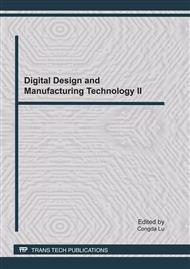p.131
p.136
p.144
p.148
p.153
p.159
p.163
p.167
p.172
Working Space Solution and Scale Fitting of a 5-Strut Parallel Machine with Swivel Joints
Abstract:
Taking a 5-axis-5-swivel parallel machine tool with swivel joints as an example, a geometric method is put forward in the paper to solve this kind of parallel machine working space. In this method, the border of the working space is found when several curves cap. This geometric mathematical model reveals the relationship betiten the structure parameters and the working space. The maximum proportion of the volume of working space is used as a target of evaluation ,and how scale parameters affect this target is also discussed. With this method, the condition of constraints could be got from the machine principles and the working space is also directly calculated. Hence, no more complex derivation process is needed.
Info:
Periodical:
Pages:
153-158
Citation:
Online since:
March 2011
Authors:
Keywords:
Price:
Сopyright:
© 2011 Trans Tech Publications Ltd. All Rights Reserved
Share:
Citation:


